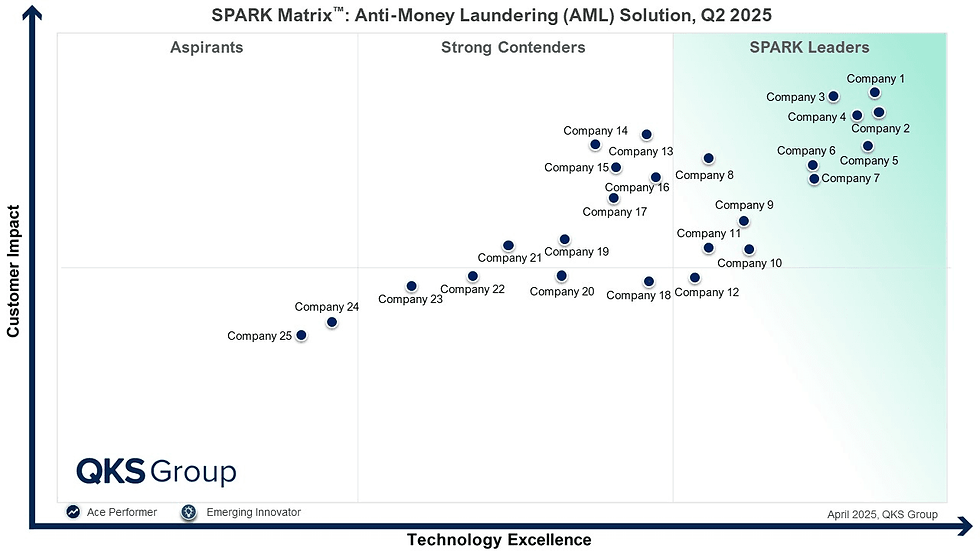Anti-Money Laundering Solutions
- Gauri Kale
- Sep 15, 2025
- 3 min read

In today’s rapidly evolving financial landscape, combating financial crime is a top priority for banks, financial institutions (FIs), and non-banking organizations alike. Regulatory frameworks worldwide are becoming increasingly stringent, making it imperative for institutions to adopt a robust and comprehensive Anti Money Laundering Solutions. Such a solution goes beyond basic compliance to deliver end-to-end management of financial crime risk, covering detection, prevention, investigation, and reporting.
A modern AML platform is not just a tool but an integrated ecosystem that brings together diverse technologies, data sources, and operational processes to ensure institutions can proactively identify suspicious activity, mitigate risk, and stay ahead of regulatory demands.
Key Capabilities of a Comprehensive AML Solution
A truly comprehensive AML solution must support a holistic range of core capabilities designed to tackle financial crime from multiple angles:
Customer Due Diligence (CDD) and Enhanced Due Diligence (EDD): These processes verify customer identity, assess risk profiles, and monitor ongoing relationships. EDD adds deeper scrutiny for high-risk customers, politically exposed persons (PEPs), and complex ownership structures.
Sanctions and PEP Screening: Automated screening of customers and transactions against global sanctions lists and PEP databases ensures compliance with international regulatory mandates and reduces exposure to reputational and legal risks.
Adverse Media Analysis: By scanning structured and unstructured media sources, this capability flags customers linked to negative news, fraud, or criminal activity, enabling informed onboarding and monitoring decisions.
Transaction Surveillance and Dynamic Risk Scoring: Real-time monitoring of transactions across channels helps detect unusual patterns. Dynamic risk scoring adjusts customer risk profiles continuously based on behavior and contextual data, improving the precision of alerts.
End-to-End Case Management and Regulatory Reporting: Integrated case management workflows streamline alert triage, investigation, documentation, and regulatory reporting—ensuring auditability and compliance efficiency.
Technology Foundation: Modern Architecture for Agility and Scale
To effectively support these capabilities, AML solutions must be built on modern, flexible architectures:
API-first and Cloud-native Design: This ensures seamless integration with core banking systems, customer relationship management platforms, and external data providers. Cloud deployment enables scalability, high availability, and cost efficiency.
Microservices-based Deployment: Breaking the solution into modular components allows independent updates, quicker enhancements, and faster adaptation to evolving regulations.
Low-code/No-code Configurability: Business users and compliance teams can quickly tailor workflows, risk rules, and thresholds without extensive developer support, reducing operational friction.
Leveraging Advanced Technologies for Intelligent AML
Modern Anti Money Laundering Solutions leverage a range of advanced technologies to enhance accuracy, reduce false positives, and improve decision-making speed:
Machine Learning (ML) and Behavioral Analytics: These analyze large volumes of historical and real-time data to detect hidden patterns, unusual behaviors, and evolving typologies of financial crime.
Fuzzy logic: Useful in matching imperfect or incomplete data, reducing missed detections due to minor discrepancies.
Natural Language Processing (NLP): Enables automated extraction and analysis of information from unstructured data sources such as news, legal documents, and social media.
Embedded Feedback Loops: Continuous learning from investigation outcomes helps models adapt and improve accuracy over time, ensuring relevance in dynamic risk environments.
Regulatory Compliance, Auditability, and Global Readiness
With regulatory environments becoming more fragmented and complex, AML solutions must ensure:
Enhanced Explainability and Auditability: Transparent model decisions, clear rationale for alerts, and complete audit trails are essential for satisfying regulatory scrutiny.
Jurisdiction-specific Rule Management: Centralized yet customizable rule engines enable adherence to diverse global regulations without disrupting operations.
Comprehensive Dashboards and Reporting: Real-time analytics give compliance officers and auditors actionable insights into risk exposure, operational efficiency, and compliance health across jurisdictions, customer segments, and channels.
The Business Impact: Operational Efficiency and Risk Resilience
Implementing a comprehensive AML solution transforms compliance from a reactive, resource-intensive burden into a proactive, strategic function. Automated data ingestion, real-time screening, and intelligent alert triage free up human investigators to focus on complex cases. This not only reduces operational costs but also improves detection accuracy, minimizing regulatory fines and reputational damage.
Moreover, by providing a unified view of risk across all customers and transactions, these solutions empower organizations to anticipate emerging threats and strengthen their overall financial crime risk posture.
Conclusion
As financial crime becomes more sophisticated and regulators demand greater accountability, the need for a comprehensive Anti Money Laundering Software has never been more urgent. By combining robust core capabilities, modern architecture, and advanced technologies, institutions can achieve regulatory compliance, operational agility, and enhanced risk resilience—while ensuring the trust and security of their financial ecosystems.
Comments